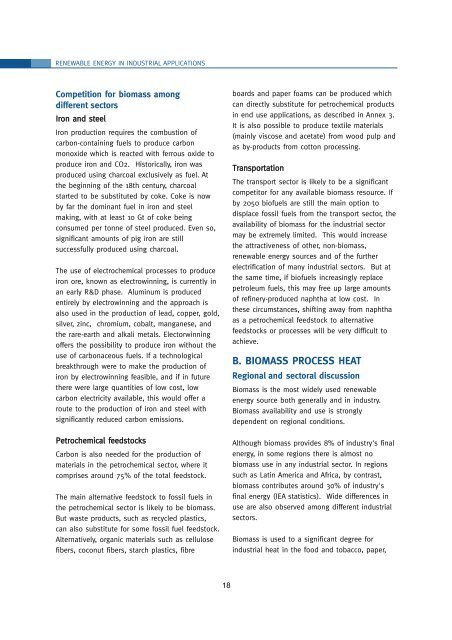Renewable Energy in Industrial Applications â an ... - Unido
Renewable Energy in Industrial Applications â an ... - Unido
Renewable Energy in Industrial Applications â an ... - Unido
You also want an ePaper? Increase the reach of your titles
YUMPU automatically turns print PDFs into web optimized ePapers that Google loves.
RENEWABLE ENERGY IN INDUSTRIAL APPLICATIONS<br />
Competition for biomass among<br />
different sectors<br />
Iron <strong>an</strong>d steel<br />
Iron production requires the combustion of<br />
carbon-conta<strong>in</strong><strong>in</strong>g fuels to produce carbon<br />
monoxide which is reacted with ferrous oxide to<br />
produce iron <strong>an</strong>d CO2. Historically, iron was<br />
produced us<strong>in</strong>g charcoal exclusively as fuel. At<br />
the beg<strong>in</strong>n<strong>in</strong>g of the 18th century, charcoal<br />
started to be substituted by coke. Coke is now<br />
by far the dom<strong>in</strong><strong>an</strong>t fuel <strong>in</strong> iron <strong>an</strong>d steel<br />
mak<strong>in</strong>g, with at least 10 Gt of coke be<strong>in</strong>g<br />
consumed per tonne of steel produced. Even so,<br />
signific<strong>an</strong>t amounts of pig iron are still<br />
successfully produced us<strong>in</strong>g charcoal.<br />
The use of electrochemical processes to produce<br />
iron ore, known as electrow<strong>in</strong>n<strong>in</strong>g, is currently <strong>in</strong><br />
<strong>an</strong> early R&D phase. Alum<strong>in</strong>um is produced<br />
entirely by electrow<strong>in</strong>n<strong>in</strong>g <strong>an</strong>d the approach is<br />
also used <strong>in</strong> the production of lead, copper, gold,<br />
silver, z<strong>in</strong>c, chromium, cobalt, m<strong>an</strong>g<strong>an</strong>ese, <strong>an</strong>d<br />
the rare-earth <strong>an</strong>d alkali metals. Electorw<strong>in</strong>n<strong>in</strong>g<br />
offers the possibility to produce iron without the<br />
use of carbonaceous fuels. If a technological<br />
breakthrough were to make the production of<br />
iron by electrow<strong>in</strong>n<strong>in</strong>g feasible, <strong>an</strong>d if <strong>in</strong> future<br />
there were large qu<strong>an</strong>tities of low cost, low<br />
carbon electricity available, this would offer a<br />
route to the production of iron <strong>an</strong>d steel with<br />
signific<strong>an</strong>tly reduced carbon emissions.<br />
Petrochemical feedstocks<br />
Carbon is also needed for the production of<br />
materials <strong>in</strong> the petrochemical sector, where it<br />
comprises around 75% of the total feedstock.<br />
The ma<strong>in</strong> alternative feedstock to fossil fuels <strong>in</strong><br />
the petrochemical sector is likely to be biomass.<br />
But waste products, such as recycled plastics,<br />
c<strong>an</strong> also substitute for some fossil fuel feedstock.<br />
Alternatively, org<strong>an</strong>ic materials such as cellulose<br />
fibers, coconut fibers, starch plastics, fibre<br />
boards <strong>an</strong>d paper foams c<strong>an</strong> be produced which<br />
c<strong>an</strong> directly substitute for petrochemical products<br />
<strong>in</strong> end use applications, as described <strong>in</strong> Annex 3.<br />
It is also possible to produce textile materials<br />
(ma<strong>in</strong>ly viscose <strong>an</strong>d acetate) from wood pulp <strong>an</strong>d<br />
as by-products from cotton process<strong>in</strong>g.<br />
Tr<strong>an</strong>sportation<br />
The tr<strong>an</strong>sport sector is likely to be a signific<strong>an</strong>t<br />
competitor for <strong>an</strong>y available biomass resource. If<br />
by 2050 biofuels are still the ma<strong>in</strong> option to<br />
displace fossil fuels from the tr<strong>an</strong>sport sector, the<br />
availability of biomass for the <strong>in</strong>dustrial sector<br />
may be extremely limited. This would <strong>in</strong>crease<br />
the attractiveness of other, non-biomass,<br />
renewable energy sources <strong>an</strong>d of the further<br />
electrification of m<strong>an</strong>y <strong>in</strong>dustrial sectors. But at<br />
the same time, if biofuels <strong>in</strong>creas<strong>in</strong>gly replace<br />
petroleum fuels, this may free up large amounts<br />
of ref<strong>in</strong>ery-produced naphtha at low cost. In<br />
these circumst<strong>an</strong>ces, shift<strong>in</strong>g away from naphtha<br />
as a petrochemical feedstock to alternative<br />
feedstocks or processes will be very difficult to<br />
achieve.<br />
B. BIOMASS PROCESS HEAT<br />
Regional <strong>an</strong>d sectoral discussion<br />
Biomass is the most widely used renewable<br />
energy source both generally <strong>an</strong>d <strong>in</strong> <strong>in</strong>dustry.<br />
Biomass availability <strong>an</strong>d use is strongly<br />
dependent on regional conditions.<br />
Although biomass provides 8% of <strong>in</strong>dustry's f<strong>in</strong>al<br />
energy, <strong>in</strong> some regions there is almost no<br />
biomass use <strong>in</strong> <strong>an</strong>y <strong>in</strong>dustrial sector. In regions<br />
such as Lat<strong>in</strong> America <strong>an</strong>d Africa, by contrast,<br />
biomass contributes around 30% of <strong>in</strong>dustry's<br />
f<strong>in</strong>al energy (IEA statistics). Wide differences <strong>in</strong><br />
use are also observed among different <strong>in</strong>dustrial<br />
sectors.<br />
Biomass is used to a signific<strong>an</strong>t degree for<br />
<strong>in</strong>dustrial heat <strong>in</strong> the food <strong>an</strong>d tobacco, paper,<br />
18

















